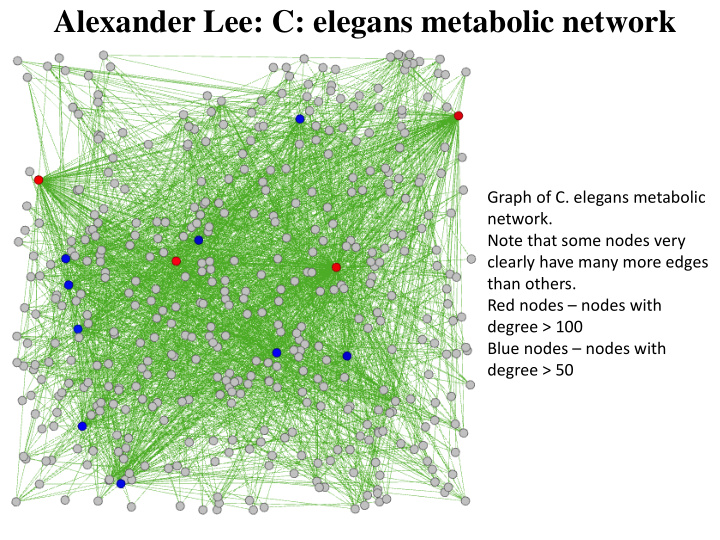



Alexander Lee: C: elegans metabolic network Graph of C. elegans metabolic network. Note that some nodes very clearly have many more edges than others. Red nodes – nodes with degree > 100 Blue nodes – nodes with degree > 50
Alexander Lee: UC Irvine communication network Graph of UC Irvine communication network. Blue nodes – nodes with degree <= 5. These nodes account for 50.0% of the network. Graph of the corresponding Graph of the random network. corresponding scale-free Red nodes – nodes with network , by definition of degree within one standard BA there are no nodes deviation of average degree with degree < 5. Blue nodes – nodes with degree = 5 (28.3% vs. 50% in the real-world network,
Alex Meandzija: Biblical Proper Noun Network Visualization of Visualization of
Bradley Mason: Article Network, use of log log scale Network of similarity of publications in "Senior Scholars‘ Basket of Journals" (the top 8 IS journals) from 2005 to 2014
Bradley Mason: article network, using betweenness centrality The network to the left is colored by modularity class and the node size is proportional to that node's betweenness centrality measure. Scaling by betweenness centrality allows us to see which articles link to many different modularity classes and reveals which articles provide work that connects and unifies different areas.
Bradley Mason: article network, using closeness centrality The network is colored according to modularity class with node size proportional to closeness centrality. Coloring by modularity allows us to see the different political groups. Because closeness measures how central a node is in the network, the large nodes in the above network correspond to blogs that pull information from a wide range of other blogs. The blogs have links to more parts of the network and are therefore presumably less partisan.
Manqing Ma: network science and Ph.D. networks Similarity revealed by proper visualization
Varun Rao & Austin Egri: Obama retweet network Notice similarity to bio-networks
Kousuke Tachida: Network of fly ( D. melanogaster ) high-throughput protein-protein interactions EPA Web Network shows the connectivity of websites that link to www.epa.gov. Note log log scales and estimation of slope of the drop which defined gamma
Kousuke Tachida: network of fly (D. melanogaster) high-throughput Protein-Protein Interactions (PPI)
Kousuke Tachida: network science coauthorship network
Tyler Shepherd: Political Blogs Network This network represents hyperlinks between Internet blogs on U.S. politics. Nodes represent different blogs and edges represent hyperlinks from oneblog to another. Edges are directed and unweighted. Each node has a value attribute indicating political leaning: 0 for liberal, 1 for conservative. This political leaning data comes from self-reported blog directories. Hyperlinks were found using a web crawler on the homepage of each blog. Data was collected and labeled around the time of the 2004 political election.
Tyler Shepherd: General Relativity and Quantum Cosmology Collaboration Network
James Flamino, using network visualization Network visualizations of the BA equivalent Usair (left) vs. the original Usair (right)
Logan Garber: Maayan FAA network Comparing real-network with its BA model
Logan Garber: Rome road network Comparing real-network with its BA (right upper corner) and ER (right lower corner) models
Christopher Jones: Yeast network Similarity and differences between real-network and its BA model
Christopher Jones: Air Traffic Control network The differences between real-network embedded in space and its BA model
Rosemonde Ausseil: Euro road network The Euro road network represents the international E-road network, in which the nodes are cities and the edges are roads. There is a central hub that has the highest degree and one of the lowest eccentricities but low (0) clustering coefficient. The more moderate hubs are all clustered together, away from the main hub. This means that there are many roads that go from the biggest city to the smaller cities. Yet, the medium-sized cities are more inter- connected.
Rosemonde Ausseil: two bio networks The Lung represents the coupled temperature The bio grid mouse network represents the and water vapor transport in a lung; there are protein-protein interactions in a mouse. Each no “important nodes” in the network, nodes node is a protein and an edge shows an are equivalent in terms of degree and interactions between them. All the hubs are eccentricity. clustered together Lung Network Graphic Representation Bio grid mouse Graphic Representation
Angelina Martineau: Communication network This network describes the email communication between members of the University Rovira I Virgili in Tarragona in the south of Catalonia, Spain. Nodes with a higher degree are colored blue and are larger. Nodes with lower degrees are red and smaller.
Recommend
More recommend